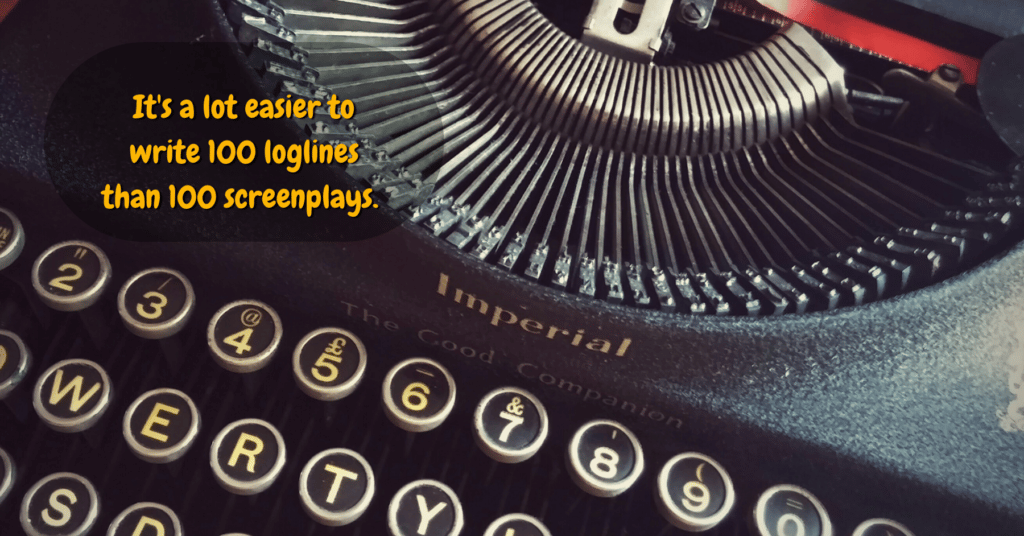Article by Colette Nichol, Solo Filmmaker and Story Strategist
Estimated reading time: 12 minutes
In this article, I’m going to share an easy and foolproof way to write a logline. So if you’ve been roaming the internet wondering how to write a logline, you’re in luck. This method is simple, fast, and works every time. The only pre-requisite is a creative brain.

Why Write a Logline?
Writing loglines is like doing pushups for your story brain. It trains your story-focused neural pathways to think about the most essential elements of a story.
The more loglines you write, the more confident you’ll be at assessing whether the basic premise of a story works or not. So, go through this foolproof process to write a logline and get started working on your next script or story.
TABLE OF CONTENTS
3. 15-minute Logline Challenge
4. How to Write a Logline with the Foolproof Logline Formula
7. Another Foolproof Logline Formula
8. How to Write a Better Logline
9. What to Do After Your Write the Logline
10. Common Questions about Movie Loglines
12. Is Writing a Logline Worth It?
13. Story Elements

What Is a Logline?
A logline is a one or two-sentence breakdown that contains the most essential story elements of a movie.
Your logline sets up the hero and the premise of a movie. If a logline is successful, it’ll make your target audience want to know more. Some people think of loglines as the elevator pitch for a movie. If you can encapsulate your movie idea into a two-sentence pitch that grabs your ideal audience’s imagination, you have a better chance of success.
Before most writers tackle a script, they’ll write multiple loglines.
Why? Because if your logline doesn’t capture attention, it’s unlikely your final script will capture attention. And it’s much less time-consuming to write 100 loglines than to write 100 scripts.

15-minute Logline Challenge
One of the things that we as filmmakers and storytellers often build up in our heads as “so difficult” and “takes forever!” is putting together a plot or a script.
Can you relate to that?
Do you think it has to take you 3 years to write a good screenplay?
Or a whole year to plot out every perfect detail of your feature?
Or at least six months to write and produce your first micro film or short?
Or 10 years to become a confident storyteller?
Story is the basis of everything we do as filmmakers.
Whether you want to be a producer, director, solo filmmaker, or video creator, story is GOD. Story is king. Story is every member of the royal family.
Story is the blood, and the sweat, and the tears!
No story, no film. Weak story, weak movie.
So, yeah—we have to get comfortable messing around with story if we want half a chance at making our filmmaking goals and dreams into a reality. Also, story is super fucking fun, and we don’t have to be so precious about it.
To that end, I’m giving you a challenge today.
THE CHALLENGE: Come up with a storyline in 15 minutes.
I’ve done it plenty of times, and so can you.
First, decide if you want it to be a short-film plot or a feature plot. Then give yourself fifteen minutes to write your logline. A logline is a one or two-sentence breakdown that contains the most essential elements of your story. It’s what makes someone want to watch your film.
How to Write a Logline with the Foolproof Logline Formula
In brief, here’s the formula: A flawed but relatable hero is tasked with a difficult but intriguing challenge that they must achieve despite uniquely bothersome obstacles.
Flawed, relatable hero + thing they’re trying to achieve + big hairy obstacle

Now at this point, you probably want to see a couple of logline examples.
Logline Example
When invisible body-snatching extraterrestrials invade Earth, estranged cousins Cameron and Iris are tasked with saving humanity while sheltering in place at a run-down cabin in the woods. Will they succeed against all odds, or will humanity be overtaken by aliens once and for all?
As you can see in the example above, we’ve got two heroes (so it’s a Buddy movie).
Their shared flaw is that they’re estranged, which indicates a level of relatable stubbornness. (Obviously, they’re going to have even more flaws than that! Ideally, contrasting sets of flaws. For example, if one main character is super uptight, then maybe the other character is extremely loosey-goosey.)
Their difficult-but-intriguing challenge is to save humanity from invisible body-snatching extraterrestrials.
And the uniquely bothersome obstacle is that, for some reason, they’re being forced to shelter in place WHILE also being tasked with saving humanity. How the hell is that going to work out???

More Logline Examples
I compiled these loglines quite a few years ago.
So I’m not even sure where I found them or whether I wrote or even modified them myself. Maybe I wrote these, maybe I didn’t! But they’re all from famous movies. See if you can figure out which movie these loglines describe.
Jason Bourne, a former CIA assassin who suffers from amnesia, sets out to track down a CIA official whilst trying to retain memories of a forgotten past.
During World War II, reclusive writer Alice has her sequestered life upended when Frank, an evacuee from the London Blitz, is left in her care. Despite initially resolving to be rid of him, Alice finds herself and her emotions reawakened by him.
After Paris, a prince of Troy has an affair with Menelaus’s wife, Helen. He decides to take her with him. Later, Menelaus’s brother uses that as an excuse to wage war against the city of Troy. (This is kind of a weak logline, but this is clearly a movie that’ll rely on the wonder of massive set pieces and our abiding interest in Ancient Greek mythology rather than a new and fresh storyline.)
Annie Lard is asked to represent herself as a juror during the trial of a mob boss, Louie Boffano. But Mark Codell threatens to kill her son Oliver if she doesn’t acquit Boffano.
Two girls from different countries swap homes for the holidays to get away from their relationship issues. However, their lives change unexpectedly when they meet and fall in love with two local guys.
Harold’s life is turned upside down by a narration only he can hear. When the voice declares that Harold is facing death, he realizes he must find out who it is and persuade it to change his fate.
After discovering the shadowy truth that Americans are being tracked by their government, disillusioned intelligence contractor Edward Snowden leaves his job at the National Security Agency. When Snowden decides to leak this classified information, he instantly becomes a fugitive from the law. Will he escape the long arm of the CIA and successfully spread his warning call to the globe, or will he be jailed for life?
Paul is a struggling writer who recently moves into a new apartment in New York. When he meets Holly, an eccentric but beautiful socialite, he hopelessly falls in love with her. Will he win her heart or get his heartbroken again?
George Bailey has so many problems he is thinking about ending it all – and it’s Christmas! As the angels discuss George, we see his life in flashback. As George is about to jump from a bridge, he ends up rescuing his guardian angel, Clarence – who then shows George what his town would have looked like if it hadn’t been for all his good deeds over the years.
Another Foolproof Logline Formula
Here’s another way you can break down the logline into fillable bits:
1) When a unique, crazy thing happens, (2) a relatable and flawed hero (3) must do a super difficult but important task (4) that’s even more difficult because of an awful obstacle.
You can fill in the blanks by copying and pasting this formula:
1) When a unique, crazy thing happens (inciting incident)
(2) relatable and flawed hero (main character)
(3) must do a super difficult but critical task (main action!)
(4) that’s even more difficult because of awful obstacles. (villain or adverse circumstances)
So, to write a logline, pull a character that’s been bouncing around in your head for years (or days or seconds) and put them into a context where something outrageous happens.
Then give them an overarching goal or action that they need to take to change their circumstances. Then give them a big hairy obstacle. Now you’ve got the through-line for your film.
How to Write a Better Logline
Sometimes you’ve written a logline, and you just need some help making it better.
What Do You Do After You Write the Logline?
Once you’ve got your logline in place, the next step is to use the Foolscap Method to plot out your film.
Which you can also do in 15-minutes. I’ll tell you more about the Foolscap Method in another blog post. So watch out for that! But today, I challenge you to come up with a logline in 15 minutes. Or you can practice identifying catchy story structures by thinking of your favourite movies and writing the loglines for those movies.
Why does this exercise matter?
Because it helps you to gain story confidence and story skills. One of the most important parts of crafting a story is making sure you’ve got all the essential elements in place.
You need a relatable hero. Every time.
You need a context that grabs attention. Every time.
You need the hero to have to do something extremely difficult but highly critical! Every time.
And you need obstacles so that the story has somewhere to go, and the hero can be forced into transformation. Every single time.
So go ahead, have a coffee and write a few loglines!
Common Questions about Movie Loglines
What is a good logline?
A good logline is a one or two sentence breakdown that contains the most important elements of your story, including a relatable hero who has a critical mission and must overcome obstacles to achieve their goals.
What are the three parts of a logline?
Your logline must contain a relatable hero, their mission (or what they’re trying to achieve) and the big hairy obstacle that’s getting in their way.
How do you write a killer logline?
To write a killer logline you need to start with a killer character. Come up with a hero that’s flawed yet relatable and think about a mission they might be forced to take based on their circumstances. It also helps to brainstorm a variety of potential inciting incidents that might pressure the character you’ve developed. The inciting incident is what gets your whole story rolling. So if your inciting incident isn’t strong, then writing a sticky logline is going to be challenging.
What is a good logline?
One of the greatest movies of all time is Casablanca. But what do you think about the logline? “A cynical American expatriate struggles to decide whether or not he should help his former lover and her fugitive husband escape French Morocco.” (This logline is by Charlotte Dekle.) What makes a logline good will depend on who you’re trying to reach. But at its core, a good logline gives you a clear picture of the main story arc, including an attractive yet flawed hero and the problem they have to overcome. If you can add some element of irony into your logline, then you get extra brownie points.
What is a logline example?
A retired assassin must hunt down and kill the men who murdered his puppy dog, the last living connection he had to his beloved and recently deceased wife. Can you guess what movie that’s from? John Wick, of course. If you want to read a ton of loglines, then take a look at the most recent Black List. Or scroll up and review some of the logline examples in this article.
Summary of Key Points
- Unless you’re a screenwriting genius, you probably shouldn’t bother writing a screenplay until you’ve go a logline that you’re happy with in place first.
- Writing loglines is a smart way to practice putting together story elements without writing hundreds of scripts from start to finish.
- Your logline must contain an attractive yet flawed hero. Ideally, this hero is relatable and flawed in a way that’ll resonate with your target audience.
- Your logline must also contain the main story arc which includes the main challenge your hero is facing and the biggest obstacle that’s in their way.
- The biggest obstacle to your hero’s success might be a villain or it might be their circumstances.
- Some writers try to include irony in their loglines because it adds additional tension and intrigue.
- Before you try writing a logline, you need to have a compelling hero in mind.
Is Writing a Logline Worth It?
Is writing a logline worth it?
Well, that’s sort of like asking if brushing your teeth is worth it. I dunno, do you want whiter teeth? When you start your story development process with a series of logline-writing sessions, you’re more likely to end up with a story that has a hook. You won’t find yourself slogging through 90-pages only to discover that your story doesn’t land. Writing a logline before you do anything else will save you time and make you a better writer.
So, yes, it’s worth it!

Elements Of A Story
When you’re putting together a logline, it helps to understand the elements of a story.
The core elements of a story are as follows: a complex main character, transformation, desire or objective, obstacles, tension, imagery, emotion, hook, takeaway and structure.
I’d suggest learning more about the basic elements of story before tackling your next project. It doesn’t take years to learn, but you will need to spend a few hours per week digging into different stories and pulling them apart.
As your next step, I recommend reading one of my most popular blog posts, which covers the top 10 elements of a good story.
Read On!
More Filmmaking Articles You’ll Love:
🎥 Filmmaking Basics Every Beginner Needs to Know
🎥 Cinematic Lighting: Epic Film Lighting Guide for Beginners
🎥 iPhone Filmmaking Tips for Beginners
Learn Filmmaking and Get the Gear Guide
If you’re interested in learning filmmaking, check out the Solo Filmmaking Mentorship Program I created for aspiring filmmakers and video creators. It usually goes live once per year. So I recommend getting the Story Envelope Filmmaking letter which comes out a couple of times per month. That way, you can get filmmaking tips for free and find out when the filmmaking course is going live again.
Also, before you go, grab the Solo Filmmaking Gear Guide and Checklist for Beginners.

About the Author
Hi! I’m Colette Nichol. I’m a solo filmmaker and story strategist based out of rainy Vancouver, Canada. I’ve been making videos and micro films for small businesses and global brands since 2014.
Plus, I LOVE to help aspiring filmmakers pursue their dreams and start making films. This blog is designed to help you gain the knowledge you need to become a filmmaker.
If you want more, get on the waitlist for the Story Envelope Academy Solo Filmmaking Mentorship Program. It opens up one time per year and is the best way to become a filmmaking or video pro fast!
CLICK HERE to get on the solo filmmaking mentorship waitlist.